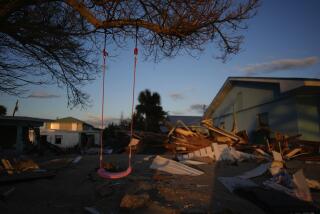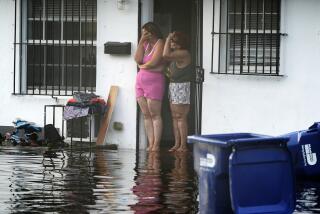Fears Grow That Florida, a State Built on Water, Is Drying Up : Environment: Lakes are vanishing. So are the ecosystems they support. Drought, rapid growth and lack of conservation are blamed.
- Share via
LAND O'LAKES, Fla. — Catherine Monsees retired to a house on a lake once stocked with fish and teeming with wildlife.
That’s all gone now.
What she has left is a dry lake bed choked with weeds and a tarnished dream for her golden years.
“We’ve been cheated out of our retirement,” Monsees said. “It’s more than upsetting. My husband wanted to kick back and fish, but we’ll never see water in that lake.”
The fish are long gone from Patriot Lake. It’s the same story with Crews Lake, now a 500-acre muddy crater. Likewise with Big Fish Lake, so named for the good-sized bass it once gave up. Now, the docks at Big Fish Lake wind over a river of scorched grass.
California’s water woes are well-known. Not so well-publicized are the problems of Florida, a state surrounded by water and built on water.
Thousands of acres of lakes and wetlands are drying up as the demand for water increases for Florida’s growing population. Other lakes are polluted from pesticide runoff and factory chemicals.
The culprits are varied: too much water pumped from natural underground reservoirs, persistent drought, rapid growth and virtually no thought for water conservation.
“A lack of alternative water sources caused the crisis we’re in today,” said Judy Williams, a member of a coalition of lakefront property owners. “It’s time to pay the piper. We’re facing an environmental catastrophe. Let’s not wait until we turn on the spigot and nothing comes out.”
Patriot Lake, where the Monsees dreamed of a comfortable retirement, dried up over the past few years. Even the rains don’t help anymore. The water disappears. It percolates down, searching for the aquifer.
From the air, the toll of heavy water usage on Florida’s lakes, wetlands and swamps is vivid--especially near a Central Florida water-pumping facility where 30 million gallons are pumped daily. Lake beds range from wet patches to lava-like fields of earth, parched and cracked under the blistering sun.
An estimated 17,000 acres of wetlands are damaged. Marshes are arid. Cypress trees are dead. Ducks, cranes, turtles and alligators are gone.
Florida always has had water problems--either too much or too little.
Dating to the last century, land was sold off to those who promised to drain it, dredge it, develop it and drive away the water.
“Water historically has been viewed as a problem in the state of Florida, not a resource,” said Richard Hamann, a University of Florida water specialist.
Today, the pendulum has swung the other way.
Police patrol neighborhoods trying to catch and fine lawbreakers who illegally sprinkle their lawns, wasting water. And Florida’s water supply is governed and protected by five powerful regional management districts, which have the power to levy taxes and impose rationing to conserve supplies.
“Cheap water is gone,” said Mark Farrell, assistant executive director for the southwest water district, which regulates water use in a 16-county area on the Gulf Coast in Central Florida. “We have issued too many permits for water.”
But the water districts’ work has drawn criticism from homeowners, environmentalists and politicians running for governor.
“I do not believe Florida has a water policy,” said Republican gubernatorial candidate Jeb Bush, the front-runner headed into the Sept. 8 GOP primary. “It has a number of water empires and would-be emperors, but no comprehensive policy. The long-term answer is a statewide water supply grid like the statewide power supply grid that would match supply with demand.”
Gov. Lawton Chiles defends the water boards’ work, but has appointed a 21-member statewide commission to examine Florida’s water shortages.
“As Florida’s population increases, the demands on water will continue to increase,” Chiles said. “There is no easy answer to this question and beware of anyone who has an easy answer.”
Water is the lifeblood of the Florida economy. It’s the engine that drives the biggest industries--tourism and farming.
It lures vacationers by the thousands to posh hotels, sprawling attractions and sandy beaches. It produces bountiful harvests of oranges, grapefruit, berries and a medley of winter vegetables.
It’s a magnet to developers who cash in on dreams of waterfront living and bring newcomers in droves to Florida’s 1,100 miles of coastline.
Generally, North Florida is considered water-rich. It has most of the state’s 1,700 streams and a plentiful amount of the 7,000-plus freshwater lakes that serve as ground water reservoirs.
The southern half of the state, on the other hand, is heavily dependent on rainfall. It has one-third of Florida’s supply of fresh water, but 75% of the state’s more than 13 million residents.
Although Florida is among the wettest states in the country with an average 54 inches of rain a year, that isn’t enough to put back what the state’s businesses and residents take out of the fragile system. Besides, about 40 inches of rain is lost to evaporation and runoff.
Making matters worse, the state is in the clutches of a five-year drought. Water experts say the drought has created an overall water reserve deficit of up to 60 inches that would take years to replace.
Aquifers are Florida’s rain barrel. An underground system of porous limestone and sandstone formations, these aquifers stretch beneath the peninsula. Like giant sponges, they soak up and store drinking water until it’s time to yield it to wells and springs that eventually feed water taps throughout Florida.
But water is consumed from the aquifers faster than it can be replaced. Until recently, there was no big push to reduce water use or develop alternative sources.
Now, the warning signs of a water crisis abound.
In northeast Florida, people who bought lakefront homes near Jacksonville have found themselves high and dry.
Near Keystone Heights, for instance, a “no diving” sign straddles a bridge over Lake Brooklyn, a throwback to bygone days. The bridge has crossed dry land for several years.
Docks are out of water hundreds of yards from the shoreline. Lake Brooklyn is 25 feet below normal. Lake Geneva is down 20 feet. In all, 29 lakes have severely reduced water levels or have dried up.
On Central Florida’s Gulf Coast, thousands of acres of lakes and wetlands have been depleted in Pasco and northern Hillsborough counties. Private wells have gone dry. And 95 lakes have been damaged or threatened.
Now, water regulators are getting an earful from residents.
“I’m speaking for thousands of people much angrier than I. Many are fed up,” said Bill Alexander, of Land O’ Lakes, vice chair for legal action for the Coalition of Lake Assns.
“People who worked hard all their lives to get just a little pinch of paradise are not going to sit by and watch it destroyed,” he said at a recent meeting of the southwest water board. “It’s time for that to stop happening. Yours is the public trust.”
More to Read
Sign up for Essential California
The most important California stories and recommendations in your inbox every morning.
You may occasionally receive promotional content from the Los Angeles Times.










